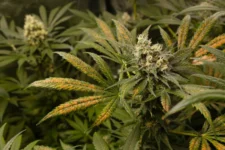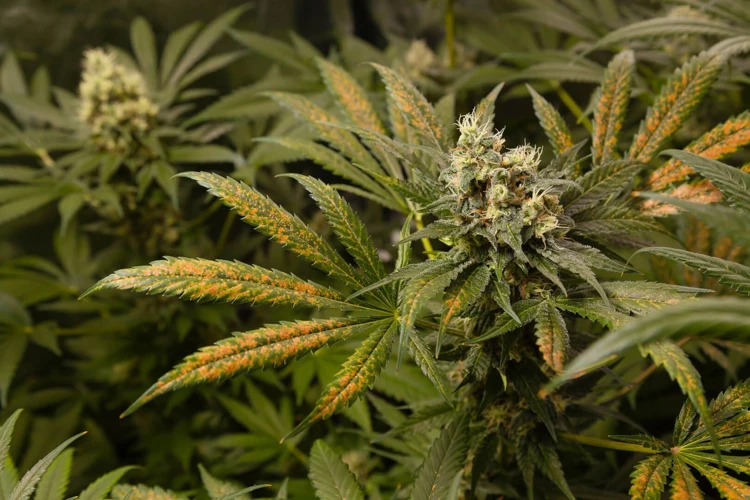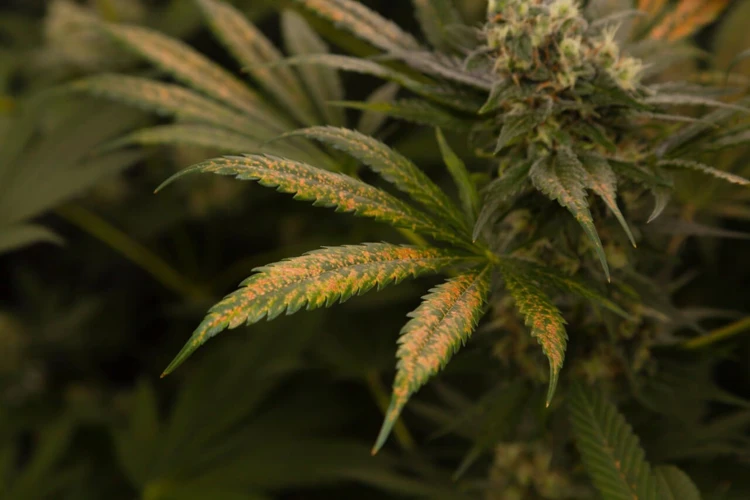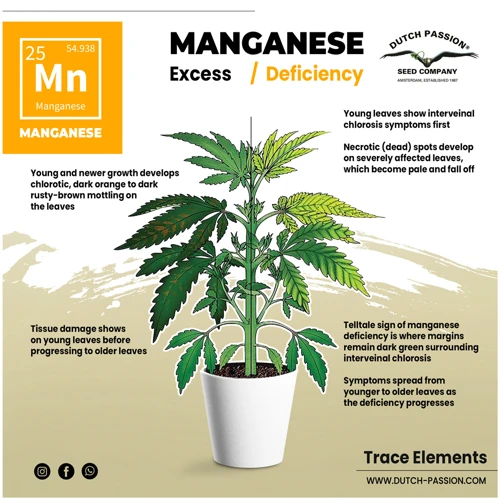
The Role of Manganese in Cannabis Growing
There are various factors that affect the growth and quality of cannabis plants. While light, water, and nutrients are the primary components required for proper growth, there are several micronutrients that are equally important. One of these micronutrients is manganese, which plays a crucial role in the plant’s overall development. However, many cannabis growers overlook the significance of manganese and fail to include it in their growing process. In this article, we will explore the importance of manganese in cannabis growing, its effects on plant growth, and the correct dosage and application of manganese supplements.
What is Manganese and Why is it Essential?
Contents
Understanding the importance of each nutrient for cannabis growth could be perplexing, but it’s crucial to provide the plants with everything they need to thrive. Manganese is one of those essential nutrients that can significantly impact your cannabis plants’ growth and yield. In this section, we will explore what manganese is and why it is an essential element in cannabis cultivation. We’ll also take a closer look at its role in plant growth and development to help you better understand its importance in cannabis production.
What is Manganese?
Manganese is a mineral element that belongs to the transition metal group in the periodic table. It has the symbol Mn and atomic number 25. Here are some interesting facts about manganese:
- Manganese is a naturally occurring element: It is usually found in mineral deposits or as part of other minerals such as pyrolusite, braunite, psilomelane, and rhodochrosite.
- Manganese is widely used in different industrial applications: It is used in the production of steel, batteries, ceramics, fertilizers, and many other products. It is also used as a pigment in paints and in the production of glass.
- Manganese plays an important role in biological processes: It is an essential nutrient for plants, animals, and humans. It is required for the proper functioning of many enzymes and helps maintain healthy bones, skin, and cartilage.
- Manganese can be toxic in high doses: While it is necessary for plant growth, too much of it can be harmful. In humans, high levels of manganese exposure can lead to neurological problems.
In cannabis growing, manganese is one of the many micronutrients that are required for the plant’s proper development. Its role in photosynthesis and enzyme activation, as well as its effect on nutrient absorption, make it an indispensable element in the cannabis plant’s growth cycle.
Why is Manganese Important in Cannabis Growing?
Manganese is an essential micronutrient for cannabis plants, and its importance in the growth and development of cannabis cannot be overstated. Manganese plays a crucial role in various plant processes, including photosynthesis, enzyme activation, and nutrient absorption.
Photosynthesis: Manganese is required for the production of chlorophyll, which is necessary for photosynthesis – the process by which plants convert light energy into chemical energy. Without adequate levels of manganese, the production of chlorophyll in cannabis plants can be disrupted, resulting in stunted growth and reduced yield.
Enzyme Activation: Manganese is also involved in the activation of many enzymes in cannabis plants. Enzymes are essential to various metabolic processes, including respiration and protein synthesis. Without sufficient levels of manganese, these processes can be disrupted, leading to nutrient deficiencies and compromised plant health.
Nutrient absorption: Manganese plays a significant role in the absorption and utilization of other essential nutrients by cannabis plants, such as nitrogen, phosphorus, and calcium. Without adequate levels of manganese, cannabis plants may struggle to absorb these nutrients, leading to deficiencies and reduced growth.
Manganese is an essential micronutrient for cannabis plants, and its importance in the growth and development of cannabis cannot be understated. A deficiency or toxicity of manganese can have significant negative impacts on plant growth and yield.
How Does Manganese Affect Plant Growth?
When it comes to the growth and development of cannabis plants, various elements and nutrients play a critical role. Manganese (Mn) is one of these essential elements that cannabis growers need to pay close attention to. Understanding how Mn affects plant growth is crucial in determining the appropriate dosage and application methods to ensure healthy and abundant yields. From the activation of enzymes to nutrient uptake and photosynthesis, manganese plays a vital role in the life cycle of cannabis plants. Let’s explore the different ways in which Mn affects cannabis plant growth.
Manganese’s Role in Photosynthesis and Enzyme Activation
Manganese plays a crucial role in the process of photosynthesis and enzyme activation in cannabis plants. Here are some ways that manganese affects these processes:
- Photosynthesis: Manganese helps in the production of oxygen during the light reactions of photosynthesis. It is a key component of the water-splitting complex in photosystem II. This complex splits water molecules into oxygen, electrons, and protons, which are then used to produce energy for the plant.
- Enzyme Activation: Manganese is also involved in the activation of enzymes that are essential to cannabis plant growth. For example, it activates enzymes involved in respiration, which is the process by which plants break down sugars to produce energy. It also activates enzymes involved in the synthesis of various compounds, including chlorophyll, which is required for photosynthesis.
Without sufficient levels of manganese, cannabis plants may experience stunted growth and reduced yields. In the next section, we will discuss the signs of manganese deficiency and toxicity in cannabis plants.
Manganese’s Effect on the Absorption of Nutrients
Manganese plays a crucial role in the absorption of nutrients by cannabis plants. The following are the ways in which manganese affects the absorption of nutrients:
- Iron and Manganese Competition: Manganese competes with iron for absorption in the roots. If there is an excess of manganese, it may inhibit iron uptake, leading to iron deficiency.
- Manganese and Calcium: Manganese also interacts with calcium as it aids in the absorption of this nutrient. If there is a deficiency of manganese, the plant may also show signs of calcium deficiency, which includes yellowing of new leaves.
- Manganese and Phosphorous: Manganese also plays a crucial role in the absorption of phosphorus. It helps convert this nutrient into a form that is easily transportable around the cannabis plant. Without adequate manganese levels, it may lead to a deficiency of phosphorus.
- Manganese and Nitrogen: Nitrogen is another nutrient that is positively influenced by manganese. Manganese aids in the process of nitrogen fixation, allowing plants to absorb more nitrogen from the soil.
- Manganese and Magnesium: Manganese also aids in the absorption of magnesium by plants. It prevents excess calcium from blocking the uptake of magnesium and ensures that cannabis plants have adequate levels of this essential nutrient.
Manganese is essential in promoting the absorption of various nutrients needed by cannabis plants to grow and thrive. It interacts with nutrients such as iron, calcium, phosphorus, nitrogen, and magnesium in various ways, making it a critical component of healthy plant development.
Signs of Manganese Deficiency and Toxicity in Cannabis Plants
One of the most challenging aspects of cannabis growing is identifying nutrient deficiencies or toxicities in plants. Manganese is no exception. Here are some signs of manganese deficiency and toxicity in cannabis plants to look out for:
Signs of Manganese Deficiency:
- Interveinal chlorosis, where yellowing initially appears between leaf veins.
- Leaf margins may also become necrotic or dead.
- Stunted growth and smaller leaves.
- Reduced plant vigor and susceptibility to disease.
Signs of Manganese Toxicity:
- Dark brown spots on leaves or leaves may appear scorched and dried out.
- Reduced growth and stunted plant size.
- Yellowing of the leaves may also occur due to reduced photosynthesis.
- Reduced nutrient uptake and the inhibition of other important minerals such as iron or magnesium.
It’s essential to always be mindful of the possibility of manganese deficiency or toxicity and aim to correct the issue as soon as possible through using proper supplementation and dosage.
Dosage and Application of Manganese in Cannabis Growing
Now that we’ve established the significance of manganese in cannabis growth, let’s further explore its dosage and application. Proper dosage and application are crucial for optimal plant growth and preventing any potential harm. In this section, we’ll dive into the appropriate manganese dosage for different stages of cannabis growth and the various methods for applying manganese in different growing media. Additionally, we’ll discuss the ideal time for applying manganese during the growth cycle to ensure maximum absorption by the plant. Let’s take a closer look at how to effectively incorporate manganese into your cannabis growing regimen.
The Right Dosage of Manganese for Different Stages of Cannabis Growth
Manganese is an essential micronutrient required in small amounts for proper plant growth and development. Its deficiency can lead to poor yields, stunted growth, and yellowing of leaves. However, excessive amounts of manganese can also be toxic to cannabis plants. It’s crucial to apply the right dosage of manganese at different stages of cannabis growth.
The Right Dosage of Manganese for Different Stages of Cannabis Growth
| Growth Stage | Manganese Dosage |
|---|---|
| Clone/Seedling Stage | 0.5-1.0 ppm (parts per million) |
| Vegging Stage | 1.0-2.0 ppm |
| Flowering Stage | 2.0-3.0 ppm |
During the clone or seedling stage, cannabis plants require a lower concentration of manganese, ranging from 0.5-1.0 ppm. This is because the young plants have a smaller root system and are not yet capable of absorbing large amounts of minerals. As the plant enters the vegging stage, the dosage of manganese can be increased to 1.0-2.0 ppm to support its growth and development.
During the flowering stage, cannabis plants require the highest concentration of manganese, ranging from 2.0-3.0 ppm. This is because the plant is producing buds and requires more nutrients to support their development. It’s important not to exceed this dosage limit, as excessive amounts of manganese can lead to toxicity and negatively affect the plant’s growth.
It’s worth noting that the actual dosage of manganese required may vary depending on several factors, such as the type of growing medium and the plant’s genetics. It’s recommended to start with a lower dosage and gradually increase it while monitoring the plant’s response.
Providing the right dosage of manganese at each growth stage is crucial for healthy cannabis growth and development. Too little can lead to deficiency and too much can lead to toxicity. It’s essential to closely monitor the dosage and adjust it accordingly.
Application of Manganese in Different Cannabis Growing Media
When it comes to the application of manganese in different cannabis growing media, the right method can ensure that your plants get the optimum level of this essential element. Here are some of the ways you can use manganese in different cannabis growing media:
- Soil: In soil, manganese can be added through mineral fertilizers or soil amendments. It’s important to note that some soils are naturally high in manganese, so it’s important to test the soil before adding more. A soil pH of 5.5 to 6.5 is ideal for manganese absorption.
- Coco coir: Coco coir is an excellent medium for growing cannabis because it offers excellent aeration and water retention. Manganese can be added to coco coir through nutrient solutions or by adding manganese oxide to the medium before planting.
- Hydroponics: In hydroponic systems, manganese can be added through nutrient solutions. It’s important to note that the pH of the solution should be between 5.5 to 6.5 for optimum absorption.
- Aeroponics: Aeroponic systems require the use of nutrient solutions that contain manganese. It’s also important to maintain a pH level of 5.5 to 6.5 for optimum absorption.
- Rockwool: Rockwool is a popular growing medium for cannabis because it offers excellent drainage and aeration. Manganese can be added to rockwool through nutrient solutions, but it’s important to monitor the pH level to ensure proper absorption.
By understanding the different methods for applying manganese to different growing media, cannabis growers can ensure that their plants get the right amount of this essential element to thrive throughout all stages of growth.
The Best Time to Apply Manganese During the Growth Cycle
When it comes to applying manganese during the growth cycle of cannabis plants, it is important to consider the different stages of growth and the specific requirements of the plant at each stage. The best time to apply manganese during the growth cycle varies depending on the stage of the plant’s development.
In the table below, we outline the different growth stages of cannabis plants and the optimal timing for applying manganese supplements:
| Growth Stage | Optimal Timing for Manganese Supplementation |
|---|---|
| Seedling Stage | Manganese is generally not required during the seedling stage, as seeds typically contain enough nutrients for the plant to get started. |
| Vegging Stage | Manganese supplementation can begin as soon as the plant starts to develop its true leaves. This is typically around day 14-21 after germination. |
| Flowering Stage | Manganese supplementation should continue through the flowering stage, which can last anywhere from 6-12 weeks depending on the strain. The plant will require more manganese during this stage due to increased nutrient demands. |
| Ripening/Harvesting Stage | Manganese supplementation is not recommended during this stage as it can affect the flavor and quality of the final product. |
It is important to note that these are general guidelines and the specific timing of manganese supplementation may vary depending on the individual needs of the plant and the specific growing conditions. It is always recommended to monitor plant health and adjust nutrient supplementation accordingly. By providing the right amount of manganese at the right time, cannabis growers can ensure optimal plant growth and development.
How to Supplement Manganese in Cannabis Growing
As discussed earlier, manganese is an essential micronutrient that aids in various growth processes of cannabis plants. However, due to certain conditions, such as low soil pH and high iron levels, the manganese levels in the soil may become depleted. In such cases, supplementing with manganese becomes necessary to ensure adequate growth and development of plants. In this section, we will explore different ways of supplementing manganese in cannabis growing, including the forms of manganese supplements and the importance of pH control in their use. Let’s dive in!
The Different Forms of Manganese Supplements
Manganese supplements come in different forms, each with its unique features that determine how it is best used in cannabis growing. Understanding the different types of manganese supplements is crucial in ensuring that you apply the right type at the right time during the growth cycle. Here are the different forms of manganese supplements you can use in cannabis growing:
| Manganese Supplement Type | Description and Highlights |
|---|---|
| Manganese Sulfate | Manganese sulfate is a soluble supplement that is easy to mix with water and applied as a foliar spray or soil drench. It is best used during vegetative growth and early flowering stages when plants require increased manganese uptake. Since the supplement is readily available to the plants, the risk of over-fertilization is high, making it necessary to use in small amounts. |
| Manganese Chelates | Manganese chelates are organic compounds that bind with manganese to form a stable molecule that is easily absorbed by the plants. They are suitable for use in hydroponics and soil-based cultivation where the pH levels are high or unstable. Manganese chelates do not react with other compounds in the growing media, making them an effective source of the nutrient. Additionally, they have less risk of accumulating in the soil or the plants. |
| Manganese Oxide | Manganese oxide is a low-cost manganese supplement that is often used in soil applications. It is insoluble, meaning it requires microbial activity to convert it into a plant-available form. However, it has a slow release time, making the nutrient available to the plants over a more extended period. Manganese oxide is best applied during the early growth stages as it takes time to break down and release the nutrient. |
| Manganese Carbonate | Manganese carbonate is a dry, chalk-like supplement that is best used in soil applications. It is insoluble and requires microbial activity to convert it into a plant-available form. Similar to Manganese oxide, manganese carbonate has a slow release time that makes the nutrient available to the plants over a more extended period. It is often used early in the growth cycle, and additional applications can be made throughout the vegetative stage for optimal results. |
Choosing the appropriate form of manganese supplement is essential in ensuring that your plants receive the necessary levels of the nutrient. It is also vital to follow the recommended dosage instructions for each supplement and monitor the plants for signs of deficiency or toxicity. By doing so, you can maintain healthy plants that are free from nutrient-related problems.
The Importance of pH Control When Using Manganese Supplements
Maintaining the proper pH level in cannabis growing is crucial for the uptake and utilization of essential nutrients, including manganese. Manganese supplements may not provide the desired results without proper pH control. Here are some reasons why pH control is critical when using manganese supplements:
- Optimal absorption – Cannabis plants can only absorb manganese effectively when the pH level of the growing medium is between 6.0 and 7.0. Maintaining the correct pH level maximizes manganese uptake in the plants, leading to better growth and higher yields.
- Prevents toxicity – Overdosing or improper use of manganese supplements can lead to plant toxicity. The ideal pH range for manganese uptake is 6.0 to 7.0. If the pH level drops below 6.0, excess amounts of manganese may accumulate and cause toxicity in the plants.
- Prevents deficiency – On the other hand, if the pH level is too high, the uptake of manganese may be limited, leading to deficiency in the plants. When the pH level is too high, manganese may precipitate and become unavailable to the plants. Maintaining a pH level between 6.0 and 7.0 helps prevent this issue.
It is important to regularly monitor and adjust the pH level of the growing medium to ensure that the plants are getting the right amount of manganese and other nutrients. Growers can use pH meters or test strips to check the pH level and add pH adjusters such as pH up or pH down as needed. By controlling the pH level, growers can maximize the benefits of manganese supplements and achieve healthy, robust cannabis plants with high yields.
Conclusion
In conclusion, it is evident that manganese plays a crucial role in the healthy growth and development of cannabis plants. From its vital role in photosynthesis to its contribution to the activation of various essential enzymes, this mineral is essential for optimal plant functioning.
It is important to note that maintaining the proper balance of manganese in the cannabis growing environment is necessary to prevent nutrient deficiencies or toxicities. This can be achieved through proper dosing and application methods based on the plant’s growth stage and the specific growing medium used.
Manganese supplements, in various forms, are available for growers to supplement their plants’ manganese levels. However, it is vital to maintain proper pH levels as manganese uptake can be impacted by fluctuations in pH.
Overall, incorporating manganese into a cannabis growing regimen can significantly enhance plant growth and optimize yield. By understanding the function of manganese and how to supplement it correctly, growers can produce healthy, high-quality cannabis plants.
Frequently Asked Questions
What are the symptoms of manganese deficiency in cannabis plants?
The symptoms of manganese deficiency in cannabis plants include yellowing leaves, stunted growth, and reduced yields.
What are the symptoms of manganese toxicity in cannabis plants?
The symptoms of manganese toxicity in cannabis plants include black spots on leaves, wilting, and slowed growth.
Can too much manganese harm cannabis plants?
Yes, too much manganese can harm cannabis plants by causing toxicity, which can result in stunted growth and reduced yields.
Can I use tap water to supplement manganese in cannabis growing?
It depends on the quality of the tap water. If the tap water contains high levels of manganese, it may not be necessary to supplement. However, if the tap water is low in manganese, a supplement may be needed.
What is the best time of day to apply manganese supplements?
The best time to apply manganese supplements is in the morning when the plants are actively growing and the temperatures are cooler.
Can I mix manganese supplements with other nutrients?
Yes, manganese supplements can be mixed with other nutrients as long as they are compatible and the correct ratios are maintained.
What is the ideal pH level for cannabis plants receiving manganese supplementation?
The ideal pH level for cannabis plants receiving manganese supplementation is between 6.0 and 7.0.
What are some organic sources of manganese for cannabis plants?
Some organic sources of manganese for cannabis plants include compost, manure, and bone meal.
What is the difference between foliar and soil application of manganese?
Foliar application involves spraying the leaves of the plants with a solution containing manganese, while soil application involves adding manganese to the soil. Foliar application provides a quicker response, while soil application provides longer-lasting effects.
How often should I supplement my cannabis plants with manganese?
The frequency of manganese supplementation depends on the growth stage of the plant and the growing environment. Generally, it is recommended to supplement every 2-4 weeks.





